Did Big Bang happen?
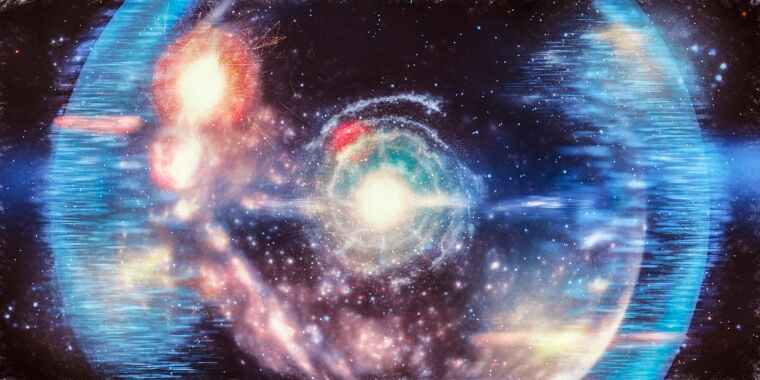
 The Big Bang is the presiding theory of the beginning of the universe that suggests everything starts from a single dot, called a singularity. From this, the universe expanded, and continues to expand until this day.
However, did the Big Bang really happen?
Despite its well held belief, you may be surprised to know that the theory was disproven at the end of the last century. In this article, we will explain this proof in more detail, and reveal an alternative theory that radically shift our whole cosmological understanding of what the universe actually is.
The Big Bang is the presiding theory of the beginning of the universe that suggests everything starts from a single dot, called a singularity. From this, the universe expanded, and continues to expand until this day.
However, did the Big Bang really happen?
Despite its well held belief, you may be surprised to know that the theory was disproven at the end of the last century. In this article, we will explain this proof in more detail, and reveal an alternative theory that radically shift our whole cosmological understanding of what the universe actually is.
Overview
The idea that the universe was formed from a singularity started to be postulated around 1912 when astronomers began to examine that light emitted from nearby galaxies. In 1923, Edwin Hubble had constructed a new 2.5 m reflector telescope, that offered greater resolution of these nearby objects. He discovered that within these galaxies there were 'Cepheids', stars whose temperature, and brightness varied in quantifiable cycles. Using these, Hubble could calculate a predicted distance. When he compared this to the existing data, he found that as the distance increases from the Earth, the light emitted, seemed to shift towards red. In 1929, he finally proposed a mathematical equation that satisfied his observations: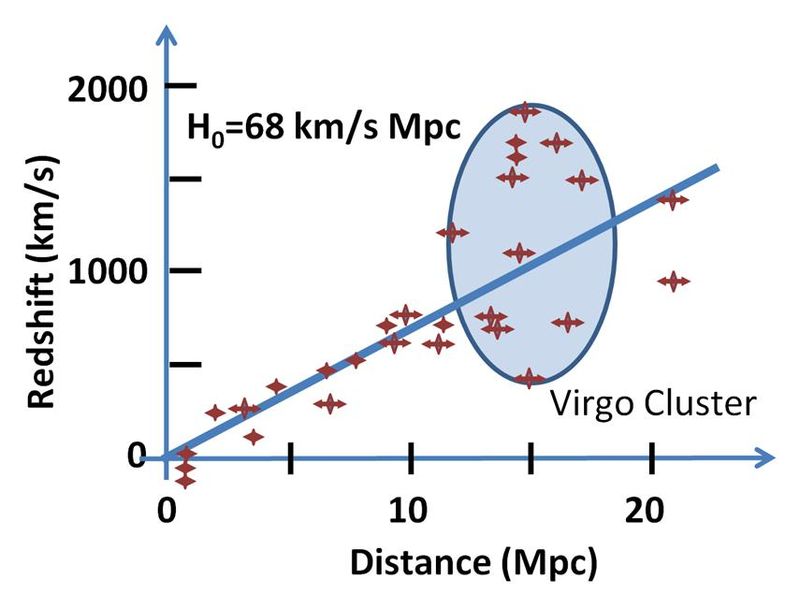
z = r x H therefore r= H/z
r =Distance H = Hubble Constant z = Redshift
Notice, that the Hubble constant (H) is correct for galaxies around the 10 megaparsec range, which is around 3×10²³ meters – 1,000,000,000,000,000 times the speed of light. After this point, Hubble's Law appears to fail. This was later compensated for by the nature of gravitation in the Virgo Galaxy Cluster, which creates the 'Red Shift distortion', officially termed 'Peculiar velocity'. Once this idea had been established, it paved the way for the 'Expanding Universe Theory'. This is based on the idea that the Red Shift was the observed effect of galaxies moving away from us, as the fabric of space-time was expanding. Additionally, the further away from us the object appeared, the faster it was moving, i.e. its velocity was increasing. This is established by the equation:v=HD
V = Velocity H = Hubble Constant D = distance in space
This equation establishes the radius of the Hubble Sphere, however, it soon became apparent that objects on the periphery of this sphere will begin to recede away from the observer at speeds greater than the speed of light. This is established by Hubble Length through the equation.c/H = Hubble length = 14.4 Billion light years
c = Speed of light H = Hubble Constant
This value is close to the accepted age of the universe, being 13.8 billion years old. However, we are able to observe objects at a distance of up to 46.5 billion light years, more than 3.3 times the expected distance.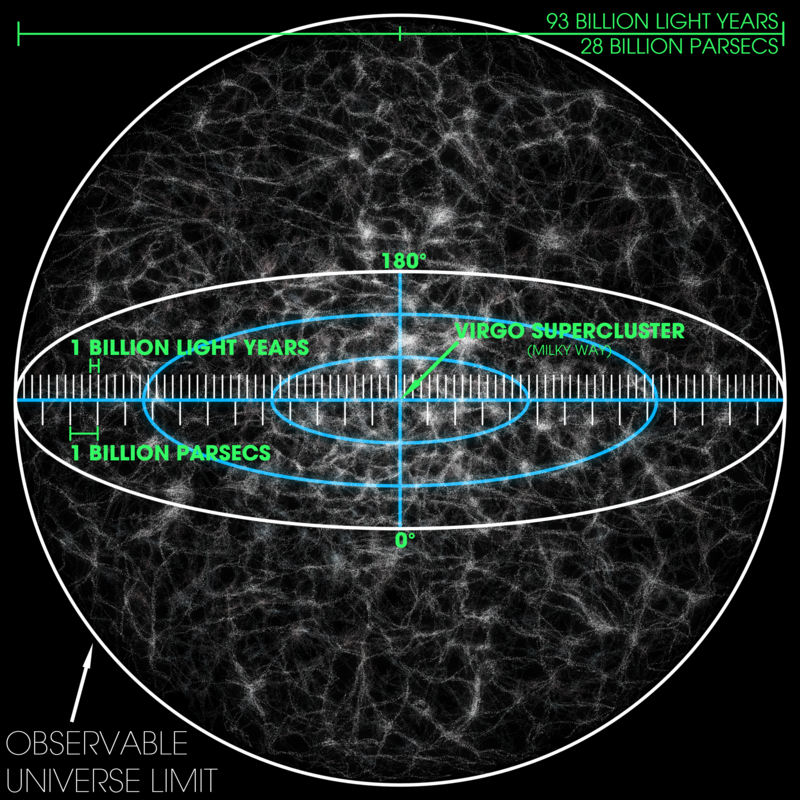 The inner blue circle represents the diameter of the Hubble constant, which is predicted for a static universe. Therefore, the reason we can view objects beyond this theoretical horizon is due to the expansion of space-time, which is accelerating. This in turn forms the basis for the Expanding Universe Theory.
Whilst the idea of an expanding universe may be calculated by increasing the rate of expansion over time, and/or altering the Hubble constant, there remains a few scientific observations that radically contradict this notion. From as far back as the 1970s, the examination of galaxies and clusters have revealed that the Red Shift does not proceed smoothly as we look further away into space. Instead, it has been found that the Red Shift is 'quantised' into discrete bands.
The inner blue circle represents the diameter of the Hubble constant, which is predicted for a static universe. Therefore, the reason we can view objects beyond this theoretical horizon is due to the expansion of space-time, which is accelerating. This in turn forms the basis for the Expanding Universe Theory.
Whilst the idea of an expanding universe may be calculated by increasing the rate of expansion over time, and/or altering the Hubble constant, there remains a few scientific observations that radically contradict this notion. From as far back as the 1970s, the examination of galaxies and clusters have revealed that the Red Shift does not proceed smoothly as we look further away into space. Instead, it has been found that the Red Shift is 'quantised' into discrete bands.
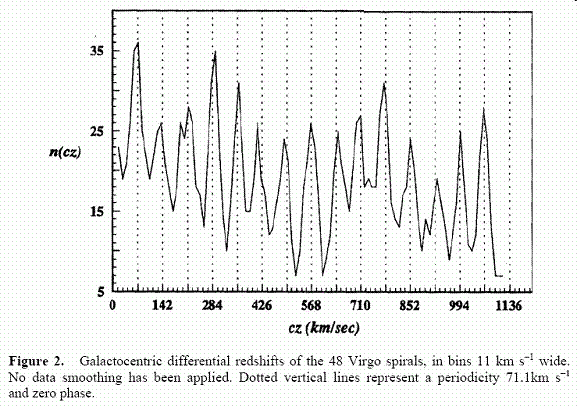 When this controversial discovery was first explored in detail at the end of the last century, it resulted in an ongoing debate between those who agreed, and those who believed it was a result of experimental error, or selective use of data.
As our capacity to observe and measure large scale structures in the universe increased, we began to build a more accurate model of the known universe. It turned out that galaxies form large superclusters, which in turn are bound together by enormous galactic filaments, sometime termed 'Galactic Walls.' these extremely large scale structures are separated by vast voids of empty space. This structured nature of the universe led to the proposal of Dark Energy, that would concentrate matter in the universe. However, to date, no evidence has emerged in support of this idea, despite vast investigation and expenditure into the subject.
Just as the electrons in an atom are 'quantised' into discrete bands, could the same principle be at work at the universal scale? Thus far, no one seems to have been able to unify the micro and macro scales of reality, into a single theory that might explain both quantum and cosmological discoveries. Yet, through the system of Dimensionless Science a picture does start to emerge, that offers an intriguing new insight into the universe at large, based on the nature of geometry.
When this controversial discovery was first explored in detail at the end of the last century, it resulted in an ongoing debate between those who agreed, and those who believed it was a result of experimental error, or selective use of data.
As our capacity to observe and measure large scale structures in the universe increased, we began to build a more accurate model of the known universe. It turned out that galaxies form large superclusters, which in turn are bound together by enormous galactic filaments, sometime termed 'Galactic Walls.' these extremely large scale structures are separated by vast voids of empty space. This structured nature of the universe led to the proposal of Dark Energy, that would concentrate matter in the universe. However, to date, no evidence has emerged in support of this idea, despite vast investigation and expenditure into the subject.
Just as the electrons in an atom are 'quantised' into discrete bands, could the same principle be at work at the universal scale? Thus far, no one seems to have been able to unify the micro and macro scales of reality, into a single theory that might explain both quantum and cosmological discoveries. Yet, through the system of Dimensionless Science a picture does start to emerge, that offers an intriguing new insight into the universe at large, based on the nature of geometry.
KEy Points
- The Universe exhibits similar structures due to the nature of 4D space
- Redshift quantisation can be qualified by the Planck Constant
- The cosmic microwave Background is the quantifyable energy of the 4D Aether
Concept
What is the Cosmological Red Shift?
In 1842 an Austrian physicist, Christian Doppler, began to examine the reason sound emitted from a fast moving object will alter its pitch as it passes an observer. He noted that upon its approach, the sound will appear higher, than when it moves away from the observer. This 'Doppler Effect' was attributed to the nature of sound waves, that are produced at shorter or longer wavelengths relative to the motion of the object. In the above image, we see the waves in front of the car are at a shorter interval than those that appear after it. Similarly, all light waves exhibit a frequency. Shorter wavelengths produce the colour blue, whereas longer wavelengths produce the colour red.
Stars are predominantly made of hydrogen, which can be identified by gaps in the visible light spectrum. This is attributed to the fact that hydrogen will absorb specific frequencies of light, which are called the spectra of the atom. We use data from spectral emissions to qualify different types of atom, as each will absorb certain frequencies. Astronomers and cosmologists examine the hydrogen spectra in order to glean information about the nature of the universe. When they examine the spectra of light emitted from distant stars, they find that the hydrogen lines appear shifted to the red end of the spectrum.
In the above image, we see the waves in front of the car are at a shorter interval than those that appear after it. Similarly, all light waves exhibit a frequency. Shorter wavelengths produce the colour blue, whereas longer wavelengths produce the colour red.
Stars are predominantly made of hydrogen, which can be identified by gaps in the visible light spectrum. This is attributed to the fact that hydrogen will absorb specific frequencies of light, which are called the spectra of the atom. We use data from spectral emissions to qualify different types of atom, as each will absorb certain frequencies. Astronomers and cosmologists examine the hydrogen spectra in order to glean information about the nature of the universe. When they examine the spectra of light emitted from distant stars, they find that the hydrogen lines appear shifted to the red end of the spectrum.
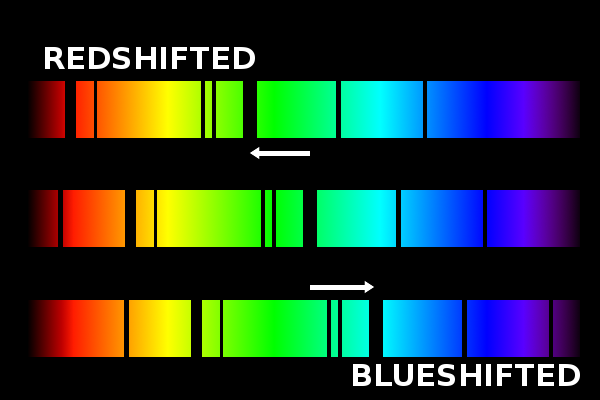 This phenomenon was therefore attributed to the idea that galaxies are all moving away from us. Out of the billions of galaxies that have been observed, only about 100 have exhibited a Blue Shift, all of which appear in our local galaxy cluster. Only a few examples are found in our closest galactic neighbours in the Andromeda cluster. All other observation show a shift towards the red spectrum, indicating they are all moving away from us.
As we look further out into the depths of space, this Red Shift increases, indicating that the rate of expansion is much greater for further away objects. The problem is that if they were just moving in space, galaxies beyond the Hubble radius, begin to move faster than the speed of light. Yet, it is well proven that matter with mass cannot be accelerated to beyond the speed of light, so the conclusion was that space-time fabric itself was expanding. This is the basis of Big Bang Theory.
https://in2infinity.com/wp-content/uploads/2022/10/How-light-redshifts-in-the-expanding-Universe.mp4
This phenomenon was therefore attributed to the idea that galaxies are all moving away from us. Out of the billions of galaxies that have been observed, only about 100 have exhibited a Blue Shift, all of which appear in our local galaxy cluster. Only a few examples are found in our closest galactic neighbours in the Andromeda cluster. All other observation show a shift towards the red spectrum, indicating they are all moving away from us.
As we look further out into the depths of space, this Red Shift increases, indicating that the rate of expansion is much greater for further away objects. The problem is that if they were just moving in space, galaxies beyond the Hubble radius, begin to move faster than the speed of light. Yet, it is well proven that matter with mass cannot be accelerated to beyond the speed of light, so the conclusion was that space-time fabric itself was expanding. This is the basis of Big Bang Theory.
https://in2infinity.com/wp-content/uploads/2022/10/How-light-redshifts-in-the-expanding-Universe.mp4
Animation of the expansion of space time
However, there are serious problems with this theory. Firstly, in order for time-space to be expanding faster than the speed of light, requires a tremendous amount of energy. This led to the idea of Dark Energy, a force that could accelerate the expansion of space-time beyond the speed of light. This view suggest that around 73% of the universe is made up of Dark Energy, whilst another 23% comprises Dark Matter, that is the substance that allows for galactic formation. With such a vast amount of energy unaccounted for, science began to seek evidence that might support this claim. Yet, despite vast numbers of experimentation, the existence of Dark Energy and Dark Matter have completely evaded detection. However, their existence is often quoted as a scientific fact, for without it the Big Bang Theory cannot be entertained. But is there another mechanism that might account for the Red Shift of distant objects in the universe? Well, actually there is.
With such a vast amount of energy unaccounted for, science began to seek evidence that might support this claim. Yet, despite vast numbers of experimentation, the existence of Dark Energy and Dark Matter have completely evaded detection. However, their existence is often quoted as a scientific fact, for without it the Big Bang Theory cannot be entertained. But is there another mechanism that might account for the Red Shift of distant objects in the universe? Well, actually there is.
Does light slow down?
Whilst light travels at a constant speed in a vacuum, once it enters into a medium such as air, it will appear to slow down. This is called the refractive index. However, light does not slow down, it moves continuously at the same speed regardless of the medium. So what does actually happen? The solution is found in the wavelike nature of light itself. White light contains all frequencies of the colours in the visible light range. When it enters into a medium of atoms, it will excite the electrons, producing a secondary wave. When this second wave combines with the first, it creates a 3rd wave that appears to move at a different rate. This video from Dr. Don Lincoln describes the process most eloquently. https://www.youtube.com/watch?v=CUjt36SD3h8 As compelling as this answer is, it is still not an accurate description of how atoms and electrons behave. The electron cloud is quantised into shells. When a photon gets absorbed by an atom, the electrons will 'jump' into a higher shell. There is no in between state, and so it cannot be said to be oscillating smoothly, up and down. Instead, the photon is completely absorbed when the electron jumps into a higher shell. When the electron falls back into a lower shell, a completely new photon is emitted. This concept lies at the heart of quantum physics. Therefore, whilst the motion of the electron may cause the modification of a light wave, it can only do so in discrete steps. In fact, it is this quantisation effect that causes the spectral lines of the various different types of atom. From the perspective of the 4th dimension, we attribute this nature to the rotation of a 4th dimensional object, such as a torus. This explains why the electrons do not collapse into the nucleus, something that it is not explained by traditional models of the atom. You can find out more about this solution in our new theory of Atomic Geometry. Once you have a correct understanding of how the frequency of light can be altered by passing through a medium, we have a new mechanism that can explain the cosmological Red Shift. Light will shift frequency when passing through a medium. However, this view is unpopular, as the vacuum of space is supposed to be devoid of atomic structures. With no atoms present, there is no secondary wavelength that can be created by the oscillation of the electron. But is the vacuum of space really 'empty'? Whilst many people have been led to believe that this is the case, the truth is, the vacuum contains a vast amount of energy. In fact, it is the energy of the vacuum that limits the speed of light.Why is the speed of light constant?
Find out more about the science of the speed of light, and discover the reasons why it is limited by the energy in the vacuum. DiscoverThe energy in the Vacuum
At the turn of the 1900s a mathematician, Max Planck, discovered that light was quantised into wave packets. This nature of light became the key turning point in the development of modern quantum theory. However, in 1911, he also postulated that in order for the theory to work there needed to be a large amount of energy in the vacuum of space itself. He termed this Zero Point Energy. However, it wasn't until 1964, that Arno Penzias and Robert Wilson experimentally discovered the Cosmic Microwave Background (CMB). This energy permeates the whole universe. When it was discovered, it was quickly assumed that this energy was the remnants of the Big Bang. However, as time passed and more analysis continued, it became apparent that this universal energy field was isotropic, uniform throughout. If a Big Bang had occurred, then it was expected to show some kind of trace, which would point towards the origin of the initial singularity. Unfortunately, this was not the case. However, rather than abandon the theory of the Big Bang, it was altered in order to compensate for this uniform nature. A new phase was added, that suggested a more rapid expansion in the early days of the universe, which in turn mixed the CMB into a seemingly uniform state, before condensing into the matter of the universe we experience today. Eventually, upon closer examination, the CBM was found to exhibit tiny fluctuations in temperature of around 0.01%, which was then used to justify its existence as the remnant energy left over from the Big Bang. However, this theory required the introduction of several new ideas, including the previously abandoned cosmological constant proposed by Einstein, and the addition of Dark Matter and Dark Energy. But the problem still remains, that the Hubble constant, when calculated through measurement of the CBM, differs from the observations of distant galaxies by around 10%. This is presently termed the 'Crisis in Cosmology'.The Cosmic Microwave Background
Explore the nature of the CBM form the perspective of the 4th Dimension. DiscoverBaryon Acoustic Oscillations
The discovery of the CMB suggests that space is flat in all directions. After this energy had been mixed into a relatively uniform medium, matter was able to condense into the galactic structures we witness today. Galaxies themselves are bound together into galaxy clusters, which in turn form galaxy filaments – the largest structures ever observed in the universe. Yet, these structures are not arbitrary. Upon closer examination of the CMB, matter in the universe is found to form in enormous spherical shells with a uniform radius of around 150 megaparsecs (4.629e+24 metres). This is believed to have been produced by the interactions of gravity and Dark Matter, which produced a phenomenon similar to a spherical acoustic wave. These are called Baryon Acoustic Oscillations. https://in2infinity.com/wp-content/uploads/2022/10/Sound-waves-in-space-Baryon-Acoustic-Oscillations.mp4 Notice, that the flat plane has extremely large peaks, distributed throughout, which expand to create each Baryon Acoustic Oscillation. However, quite how these peaks can be created from an explosion from a singularity (Big Bang), has no proven explanation. These radii are so exact that they offer a new methodology for qualifying the relative spacings of distant galaxies. However, when considered from the perspective of geometry, the fact that galaxy clusters lie upon uniform spherical shells is particularly interesting. We find the first elements in the atomic structure exhibits the same form: a central nucleus surrounded by a spherical shell. Indeed, we can say that the galactic structures are quantised in their appearance, with the highest probability of finding the nearest adjacent galaxy centring around the Baryon Acoustic radius.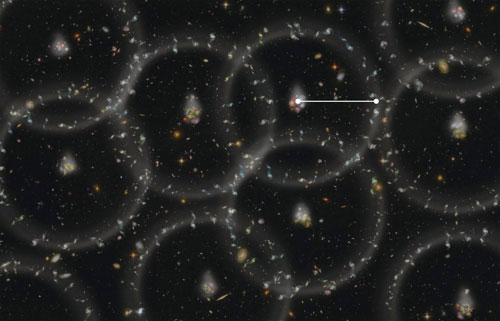
Baryon Acoustic Oscillations show an even spacing of galaxies in spherical shells.
The quantised Red Shift
Thus far, all the cosmological discoveries that we have discussed can be theorised to fit a Big Bang model of the universe, even if it requires the addition of several unproven concepts, such as Dark Matter and Dark Energy. However, one phenomenon that does not agree with the model is the nature of the 'Quantised Red Shift'. Through the examination of interstellar objects, particularly quasars, we find that the Cosmological Red Shift Theory tends to break down. In some examples, a quasar with greater Red Shift values have been found in front of galaxies with a lower Red Shift value. Furthermore, these Red Shifts often appear at specific values. Whilst there may be some correspondence between the Red Shift and distance, quite clearly this is not the case for all observed phenomena.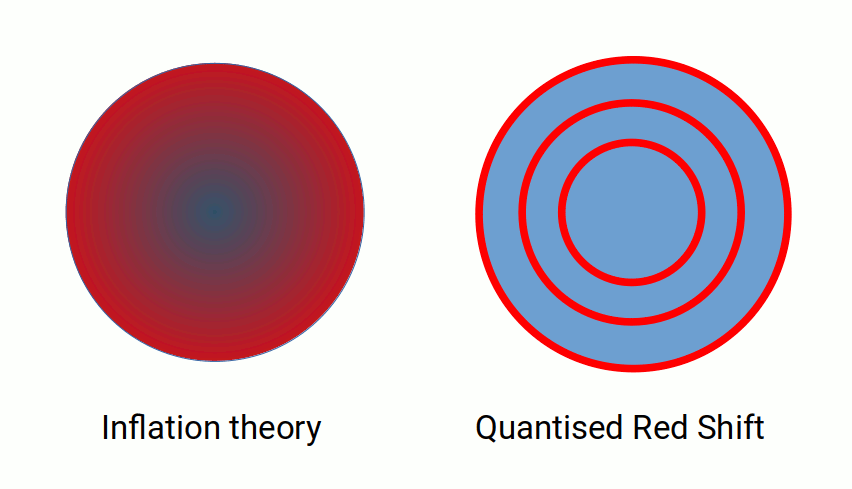 In order for the Red Shift to be attributed to velocity, and distance, as per the Big Bang Theory, it requires a smooth expansion rate. If the Red Shift were found to be quantised, it would call the whole idea of expansion into question. To understand why, we can imagine that as space expands, galaxies that are further away should exhibit a smooth shift towards the edge of the universe. The quantisation of the Red Shift on the other hand suggests that it is not caused by the expansion of space. If it were, the universe would have periods of rapid expansion, followed by periods where it ceased to expand. Yet, there is no model that could explain this energetic transition.
Many scientific studies have demonstrated that the Red Shift is quantised, not just in terms of the universe at large, but even within the structure of a single galaxy or cluster. This began in the 1970s and has continued to be confirmed as recently as 2020. In particular, William Tiff (1991) concludes that the periodicity of the quantised Red Shift has a ratio of 8/3, from which all other values are derived.
Today, we find that the idea of the quantised Red Shift has been discredited by mainstream science. However, examination of its critiques reveals various tactics, from the smearing of data sets, suggestions that those who perform the analysis were 'selecting data' to fit their views, to out-right dismissal without due consideration of the facts. One main problem is that science does not have a model that can accommodate the Quantised Red Shift phenomena. However, as those who research the debate can clearly see, there is an issue with the one-to-one correspondence of Red Shift values, and the Doppler Effect of the space-time continuum.
In order for the Red Shift to be attributed to velocity, and distance, as per the Big Bang Theory, it requires a smooth expansion rate. If the Red Shift were found to be quantised, it would call the whole idea of expansion into question. To understand why, we can imagine that as space expands, galaxies that are further away should exhibit a smooth shift towards the edge of the universe. The quantisation of the Red Shift on the other hand suggests that it is not caused by the expansion of space. If it were, the universe would have periods of rapid expansion, followed by periods where it ceased to expand. Yet, there is no model that could explain this energetic transition.
Many scientific studies have demonstrated that the Red Shift is quantised, not just in terms of the universe at large, but even within the structure of a single galaxy or cluster. This began in the 1970s and has continued to be confirmed as recently as 2020. In particular, William Tiff (1991) concludes that the periodicity of the quantised Red Shift has a ratio of 8/3, from which all other values are derived.
Today, we find that the idea of the quantised Red Shift has been discredited by mainstream science. However, examination of its critiques reveals various tactics, from the smearing of data sets, suggestions that those who perform the analysis were 'selecting data' to fit their views, to out-right dismissal without due consideration of the facts. One main problem is that science does not have a model that can accommodate the Quantised Red Shift phenomena. However, as those who research the debate can clearly see, there is an issue with the one-to-one correspondence of Red Shift values, and the Doppler Effect of the space-time continuum.
A New Horizon
For those who have explored the cosmological debate, presently there are a few alternatives to the standard Big Bang Theory. These proposals range from steady-state, non-expanding universal theories, the electric universe theory, to various other models that see the adaptation of conventional scientific laws, which may have changed over time. Yet, one type of theory is missing: The 4D Geometric Universe. Surprisingly, the geometrician has not had much to say on the subject, which is quite amazing when you consider that space is fundamentally geometric in nature. The main reason for this appears to be that both Big Bang, the Electric Universe, and other models, are based in the measurement of energy, not geometry. Secondly, the standard approach employs the use of numbers that are scaled to a specific order of magnitude, rather than considering the ratio of phenomena. Our new system of Dimensionless Science provided a simple solution to the mathematics of science based on the ratios found in geometry, which defines over 40 scientific constants that weave into a coherent picture of reality. Using this system, we find that we can draw new conclusions regarding the cosmological nature of our universe, too. However, to fully grasp the notion requires that we approach many aspects of science through a slightly different lens. To begin, we can see that the universe is filled with energy. The Zero Point Field and the Cosmic Microwave Background are one and the same: a 4D Aether, that permeates the entire universe. This was discredited at the turn of the 1900s and replaced by the idea of a photon of light, yet even this still requires a background energy in order for it to travel through space. The CMB is the perfect candidate. From this view, the photon is not a particle or wave packet. The photon is a wave. The quantisation effects are due to the 4th dimensional nature of space itself. Light does not travel through space, it is projected in quantised steps through the rotation of a 4D polytope. This concurs with the fact that a photon is completely absorbed by an atom, and a new photon is subsequently released. In our 4D theory of the universe, this energy initiates a 4D rotation.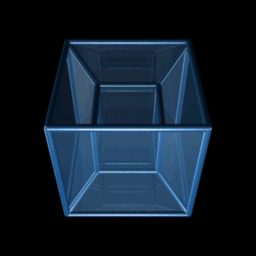
4D rotation explains why the electron cloud is quantised.
In the above example, notice how the cube at the centre is constantly replaced by the outer cube. Just as an electron moves into a higher shell as it absorbs the 'photon' and collapses back down to release the photon. In 3D, we only appreciate the quantised steps, not the rotation itself. Between the inner and outer cube, a sphere can be placed. For an inner cube with a side length of 1, the surrounding sphere will have a diameter of √3. The ratio is therefore 1: √3. In the 4th dimensional view, the universe is recreated over and over again, millions of times a second, at the smallest scales of the universe, which is expressed as the nature of time. 4D objects include both time and space, and are in constant motion. This expresses both an expansion and contraction simultaneously, a notion that is outside scientific consideration of the universe. However, this does solve the problem of the expanding universe. If the universe were static, it is believed it would collapse into itself. However, we can also say the same thing about the atom. It is worth pointing out that no scientific theory outside our 4D model of the atom can explain why the quantised structure of the electron cloud is so stable, or why the electron does not collapse into the atomic nucleus. The structure of 4D space is in continuous motion, which in turn generates the stability of 'space' and our notion of time. This provides a solution to the problem of Dark Energy. A foamy space-time would have limits on the accuracy with which distances can be measured. Space-time uncertainties could accumulate at different rates as light travels through the vast distances. In other words, the Red Shift could also be attributed to the nature of space-time itself. Indeed, when we observe the great galactic filaments, which act as an interconnecting web between galactic formations, it is entirely possible that this could create a perceived Red Shift. In 2005, the MAGIC (Major Atmospheric Gamma-ray Imaging Cherenkov) telescopes detected that certain photons at different energy levels seemed to arrive at different times, contradicting the idea that light travels at a constant speed. These observations are explained by the nature of virtual particles that manifest at the smallest scales of reality, which suggests that space-time itself acts like tiny bubbles. This is called Quantum Foam.4D quantum foam
Find out more about quantum foam and the nature of virtual particles Discover moreThe Fractal holographic universe
The fact that the CMB exhibits Baryon Acoustic Oscillations that are spherical in nature suggests that space-time can be considered as a quantised phenomenon even at the intergalactic scale. The dimensions of the Baryon spheres denotes a radius of around 500 million light years, is equivalent to around 4.730365236e+36 pico meters. In quantum physics, the Bohr radius is normally used to calculate the size of a single hydrogen atom, giving it a radius of about 52.9 pico meters. Whilst differentiated in scale, the two values are actually quite close to each other, with a variation of only 5.6, (or 28/5). However, the actual measured radius of the hydrogen atom is only around 25 pico meters, a fact that present atomic theory cannot account for, but is explained in our theory of Geo-quantum mechanics. If we take the pico meter value for the baryon spheres and divide it by √3 we get 2.7e+36, which is only 0.2 out from the real hydrogen radius, when scaled to the atomic level, well within the experimental error value.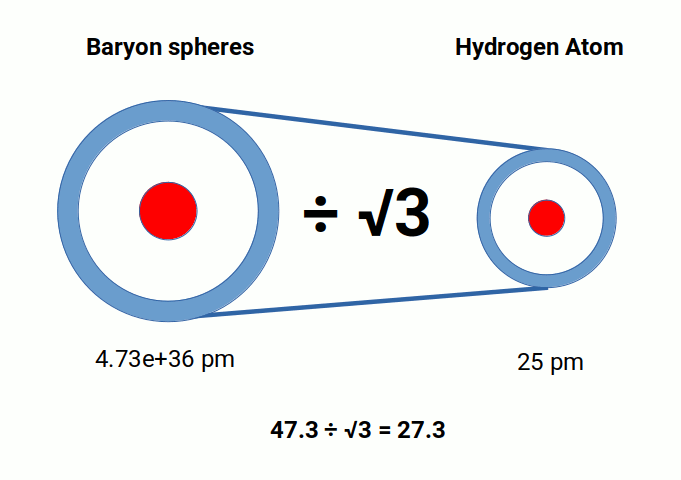 But why divide by √3? Well, it turns out that the fastest speed at which sound can travel in an infinitely dense medium is √c, the speed of light. If the speed of light is set to 3 then the fastest speed of sound becomes √3.
Both the baryon sphere and the hydrogen exhibit matter at the centre, and in the spherical surrounding shell, with a 'gap' or void where no electron or galaxy is present. The baryon spheres are primally comprised of hydrogen atoms, and both exhibit the same geometry.
The whole in the part and the part in the whole exhibit the same structure. This is the nature of fractal geometry. If an observer were to exist at a large enough scale, much larger than the universe, they would see the Baryon sphere in the same way that we perceive that atom. This structure reflected at different scales is an indication that the universe might be fractal holographic in nature. A fractal will exhibit a repeating pattern at different scales. Whereas a hologram contains the complete image in each smaller part. If you cut a hologram into two smaller parts, the image is still reproduced for each piece in entirety.
But why divide by √3? Well, it turns out that the fastest speed at which sound can travel in an infinitely dense medium is √c, the speed of light. If the speed of light is set to 3 then the fastest speed of sound becomes √3.
Both the baryon sphere and the hydrogen exhibit matter at the centre, and in the spherical surrounding shell, with a 'gap' or void where no electron or galaxy is present. The baryon spheres are primally comprised of hydrogen atoms, and both exhibit the same geometry.
The whole in the part and the part in the whole exhibit the same structure. This is the nature of fractal geometry. If an observer were to exist at a large enough scale, much larger than the universe, they would see the Baryon sphere in the same way that we perceive that atom. This structure reflected at different scales is an indication that the universe might be fractal holographic in nature. A fractal will exhibit a repeating pattern at different scales. Whereas a hologram contains the complete image in each smaller part. If you cut a hologram into two smaller parts, the image is still reproduced for each piece in entirety.
The Egg carton Universe
Closer examination of galactic superclusters reveals other geometric structures. It appears that their formation adheres to an Octahedral Geometry. Again, we find the same shapes generated by the P-orbital electrons in the atom. Notice, that the orbitals form the 'Internal Geometry' of the Octahedron, whereas the Galactic Superclusters adhere to the external side lengths.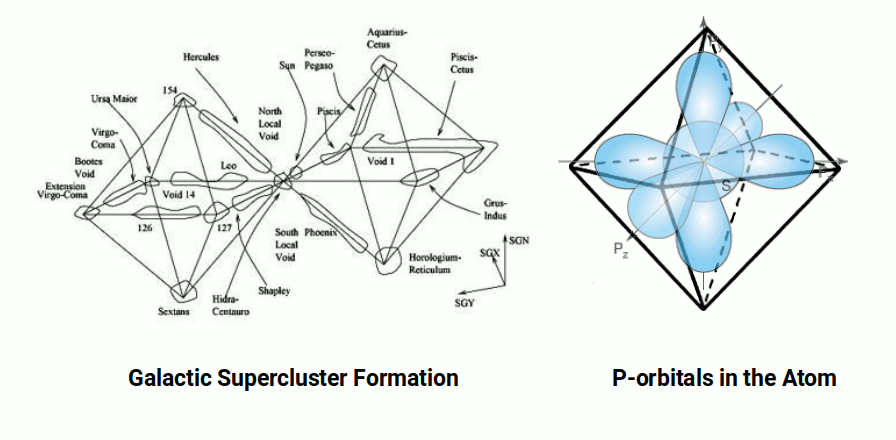
You can find out more about the geometric nature of the atom in a new theory of Atomic Geometry.
Not only does the octahedral nature resolve the Dark Energy problem of the standard model, it also reveals the fractal holographic nature of the Universe from the micro to the macro. Additionally, we find that completed P-orbital sets in the atom produce noble gas elements that are completely inert, and do not form bonds with other atoms. When we consider the similarity between the geometric appearance of the universe, and that of the atom, a new picture begins to emerge, one that sees geometry as the prime cause that structures matter in space.The quantised Universe
The fact that energy levels in the universe are quantised is a well established scientific fact. Whether we are examining the atomic structure, or photons travelling through vast distances of intergalactic space, quantisation is apparent. Therefore, it does not seem out of the question that the Quantised Red Shift should be a measurable event. Barry Setterfield who believes that the Red Shift is quantised, postulated that there may be a relationship between the quantisation of the atom, and those at the galactic scale. The quantisation of light was first discovery by Max Planck, who ascertained a specific value for each quantised energetic step. The Planck constant, denoted by the letter h, is therefore one of the most important constants in quantum physics. However, the reason for this specific value remains somewhat of a mystery. Present measurements place the value at 6.62607015×10−34 joule-hertz−1 (joule-seconds). Dimensionless Science expresses the Planck constant as √(3³/4³) / π², which is confirmed through the dimensionless value for the Fine Structure constant. This is termed the 4D cubic solution, as it expresses two types of cube, one with a side-length of 3, and the other a side-length of 4. The volume of the smaller cubes is divided by the larger and the root value ascertained. This defines the hyper cubic relationship. Subsequently, this is divided by π², which is a function of 4D torus that has an overall radius of 1, with a ring diameter of ½.
You can find out more about the Planck Constant through our new system of Dimensionless Science.
The 4th dimensional interpretation of the Planck constant translates the volume of a Torus into the Volume of a Hypercube. The energy quantisation can only occur once the entire body of the torus 'passes through' our 3D reality, to produce a single quanta of energy. When we examine the hyper cubic nature of the above explanation, we find that it has another expression. The value √(3³/4³) is express as √(27/64) which is equal to 3√3 / 8. The value 3√3 is the diagonal of a cube side length 3. When we divide this value by √3, the result is 3/8 or 0.375, which is the exact value discerned by William Tiff for the Quantised Red shift constant. The reason why we divide by √3 is that it is the relationship of the sphere that sits inside the cube, to the sphere that encompasses it.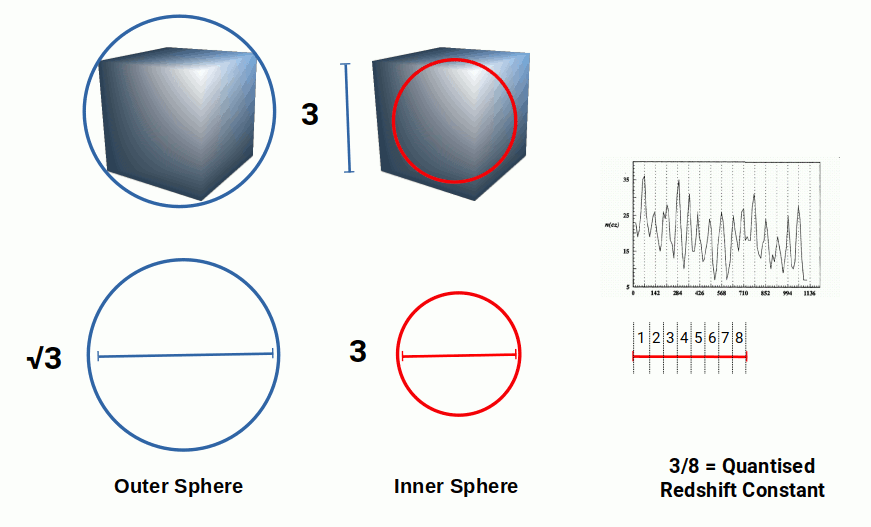 What we have just proposed will need a bit of contemplation in order for the deeper meaning and significance to be realised. However, we can say that the unification of the Planck constant with the ratio of the Quantised Red Shift is the first step to exploring the 4D Geometric Cosmological model. Not only does this seriously challenge the mainstream view of an expanding universe theory, it also begins to explain why the universe is quantised at the intergalactic scale. It begins to introduce the idea that the Cosmic Microwave Background is not the remnants of a Big Bang explosion, which can only be introduced with quite implausible qualities such as undetectable Dark Matter or Energy. Instead, the universe simply adheres to a geometric 4D structure, which is the force that maintains the structure of the universe at all scales of existence.
No other theory can fit the box without contradiction or without having to introduce mysterious concepts, such as the expansion of space-time at speeds faster than the speed of light. This has no scientific bases other than the perceived Cosmological Red Shift. Once we begin to study the universe from the view of 4D geometry, the nature of time and space are revealed, which in turn offers a fresh universal perspective. Whilst this is just a first step for this new theoretical model, we have found that it is capable of answering many questions that the mainstream model cannot explain.
THE
What we have just proposed will need a bit of contemplation in order for the deeper meaning and significance to be realised. However, we can say that the unification of the Planck constant with the ratio of the Quantised Red Shift is the first step to exploring the 4D Geometric Cosmological model. Not only does this seriously challenge the mainstream view of an expanding universe theory, it also begins to explain why the universe is quantised at the intergalactic scale. It begins to introduce the idea that the Cosmic Microwave Background is not the remnants of a Big Bang explosion, which can only be introduced with quite implausible qualities such as undetectable Dark Matter or Energy. Instead, the universe simply adheres to a geometric 4D structure, which is the force that maintains the structure of the universe at all scales of existence.
No other theory can fit the box without contradiction or without having to introduce mysterious concepts, such as the expansion of space-time at speeds faster than the speed of light. This has no scientific bases other than the perceived Cosmological Red Shift. Once we begin to study the universe from the view of 4D geometry, the nature of time and space are revealed, which in turn offers a fresh universal perspective. Whilst this is just a first step for this new theoretical model, we have found that it is capable of answering many questions that the mainstream model cannot explain.
THE
Conclusion
Did Big bang really happen?
No one can be sure how the universe started. However, the 4D Geometric Cosmological Model does not need an expanding universe in order for it to maintain a sustainable universal structure. It appears more tenable than the idea that the universe is expanding at speeds greater than the speed of light, and does not rely on mysterious Dark Energy or similar concepts to make it work. Instead, we see that the universe is a fractal holographic entity, whose fundamental geometric patterns are exhibited at various scales.
Is the Universe expanding?
From the 4D view, the universe is expanding and contracting simultaneously, a quality that is only produced by 4D phenomena. The background energy of space is in constant fluctuation, which is the mechanism through which it is maintained. Energy, the foundation of all matter, is therefore quantised by the geometric nature of space, not the wave-particle nature of the photon. This causes the quantisation of the Red Shift. Other cosmological redshift effect are attributed to the zero-point energy of the vacuum, which acts like a 'fog' to shift light spectra towards the infrared zone. This causes the limitation of the observable universe, a sphere with a diameter of around 93 billion light years. Interestingly, elements 93 is also where the series of synthetic elements begin on the periodic table.
Carry On Learning
This article is part of our new theory on the 4D AETHER. Browse more interesting post from the list below.

YOUR QUESTIONS ANSWERED
Got a Question? Then leave a comment below.
Question?
If the Cosmic Microwave Background is not the remnants of the big bang, then where did it come from?ANSWER?
The cosmic background radiation is the measurable energy produced by the 4D Aether. Light can emerge as matter in the universe once it 'condenses' around a black hole. It has already been proven that a Black hole sits at the centre of the Milky Way. We suggest the same will be found at the centre of the sun, which explains why sunspots are significantly colder than the surface temperature, which in turn is much colder than the surrounding corona. As to the reason why the CMB is not associated to a zero point field is a matter of opinion. However, it is clear that mainstream science has gone to extreme lengths to eradicate the notion of the Aether, despite the fact that the wave like nature of the photon requires it. For some, this might be an indication of a vested interest in maintaining control of the energy production systems on earth, in order for profit and gain. Or maybe it is because the 4D Aether is difficult for science to quantify due to the fact that it can only be assumed by the vast amounts of 'missing' energy, needed to formulate current theories.
Comments
Post a Comment